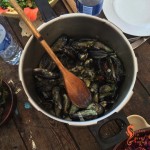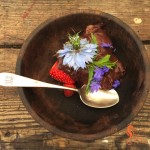
After foraging on the sea shore for edible seaweeds and mussels under the guidance of Roushanna and Gael from Good Hope Gardens, we returned to Gael’s house in Scarborough to prepare a meal with our finds. The group divided into four, and we worked together to prepare the food using recipes provided by Roushanna.

Sushi rice mixed with finely chopped sea lettuce (Ulva spp) formed the base of vegetarian sushi rolls, which were decorated with kelp, tongue weed, radishes, avocado, mayonnaise, and a secret sauce (recipe for the rolls here). Sea lettuce was also the seaweed of choice for a couscous and rocket salad, decorated with hibiscus flowers and miniature tomatoes (recipe for the salad here).
I worked on the coleslaw, made from finely sliced red cabbage, carrots, and hanging wrack (Brassicophycus brassicaeformis) – a seaweed I found so tasty and crunchy I could have sat right there in a rock pool and eaten it directly off the rocks. The mussels were picked over, scrubbed, and prepared with white wine, cream, onion, and garlic. Crusty ciabatta soaked up the sauce. Once we were done, it looked as though we had enough mussel shells for our own personal shell midden!

Roushanna prepared nori (purple laver, Porphyra capensis) crips for us (like kale chips, but with a crispier texture and more flavour), and chocolate nori ice cream for dessert. We supplied our own drinks. During breaks in the lunch preparation some of the group enjoyed a face (and hand) mask made from seaweed ingredients. Others of Roushanna’s recipes you can explore for yourself are for sea biscuits (scones made with sea lettuce), fruity vegan jelly, and kelp and avo salad.
Lunch was a collaboration, and a tasty culinary adventure. I found it marvelous to discover what is available on the sea shore, and to get a small hint of how our strandloper ancestors foraged on the Cape Peninsula.

(Puzzled what this is all about? Read my first post about coastal foraging here.)




























